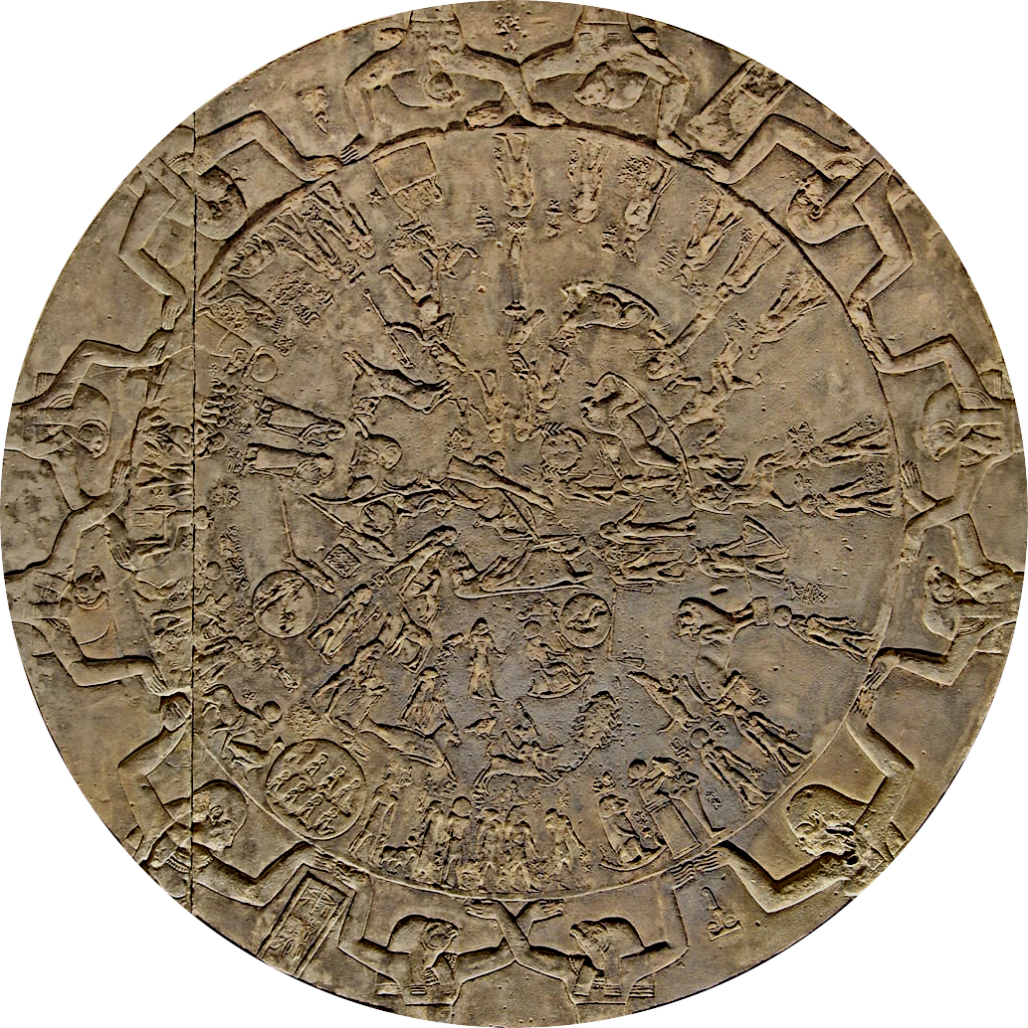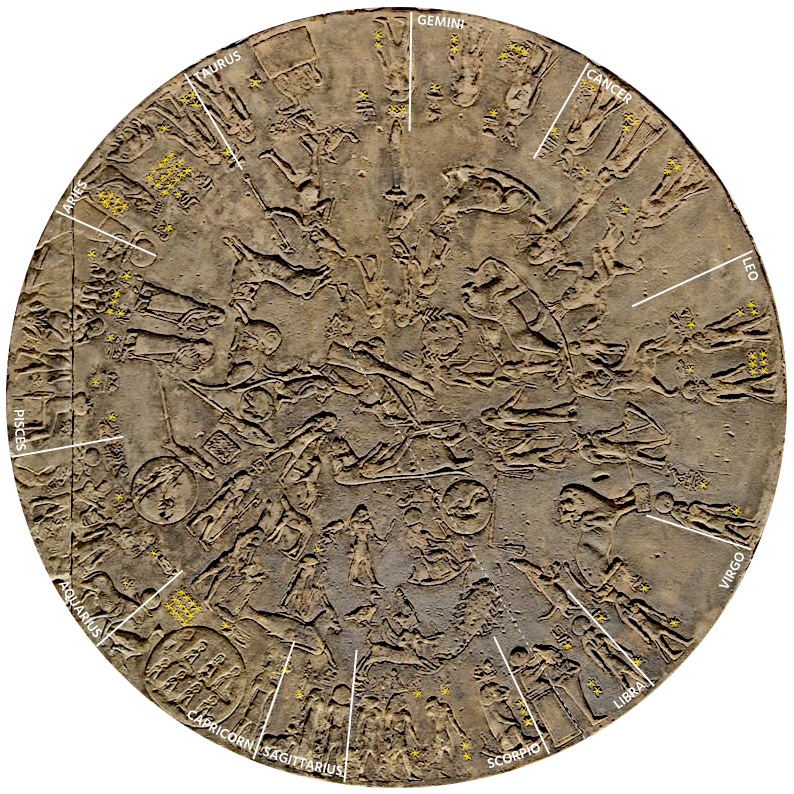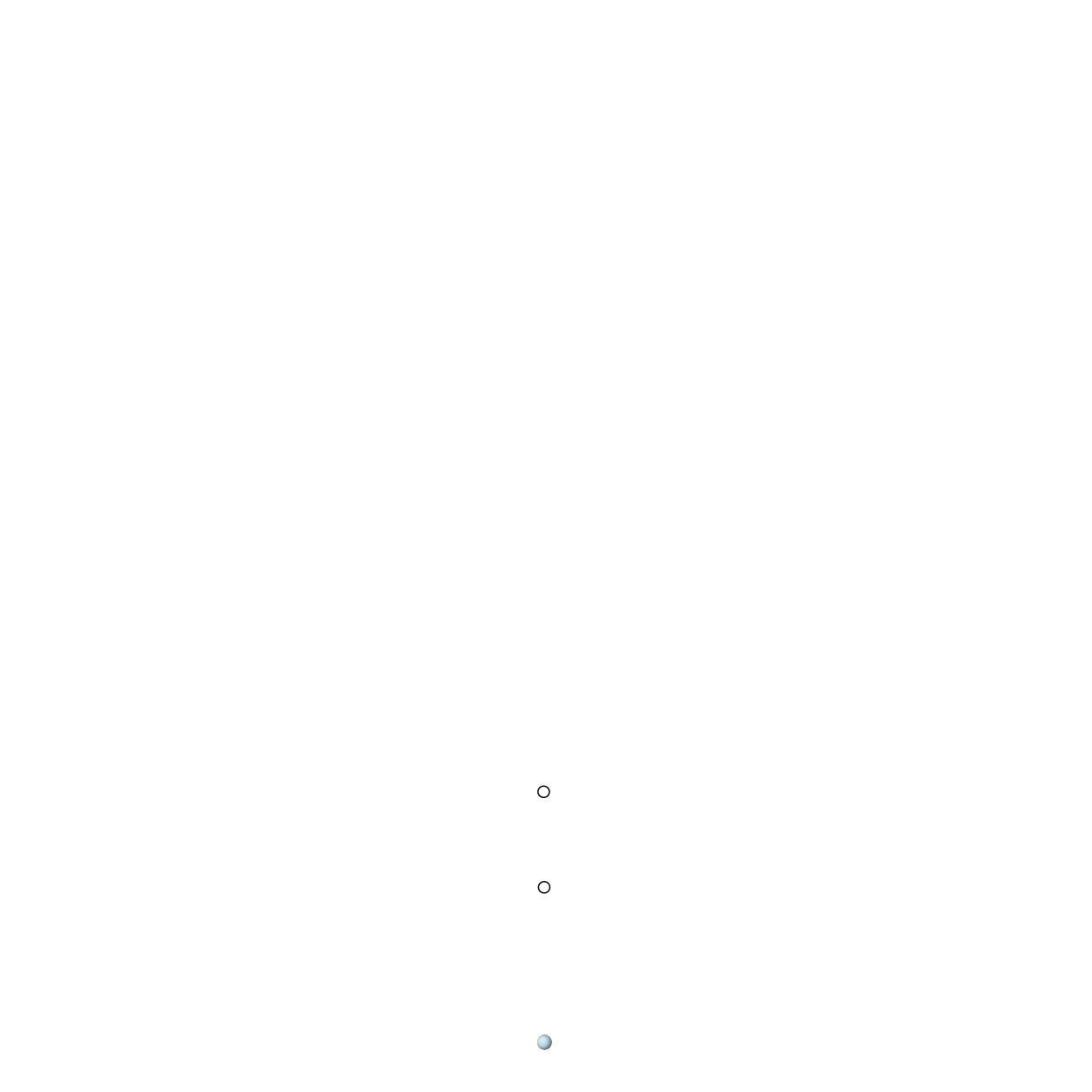The Dendera Zodiac
Uranus
Page controls
This website animates the sculpture using the NASA DE441 and DE431 ephemerides, which contain the highly accurate positions of the solar system planets, as its data sources for the angular rotations that
are applied to the sculpture's component parts. This data is available in the right panel of this page in the 'technical data' tab. The animation can be reset at any time by clicking the button below and
the zodiac carvings on the inner circle of the sculpture can be viewed at any time by clicking on the other button.
(Click and hold)
This particular webpage, on the right side panel, explains the sculpture's Uranus model and follows on from the previous page which explained the Jupiter system.
It is advised to read that page before reading this one.
Uranus carving

Explanation
Technical data
Uranus
Zodiac sign Cancer
The sculpture of the God that represent Uranus has never been previously identified on the Dendera Zodiac because there has always been the incorrect assumption that the sculpture
is limited to only five planets.
This assumption is based on the fact that there are only five Gods/planets on the central circle that are named using hieroglyphs and the fact that the planet Uranus is such a feint object in the night sky and has such a slow rotation around the Sun that it was not identified as being a planet until the advent of telescopes and was first documented in modern times in the year 1781. The God representing Uranus is shown on the left panel of this page in detail and is highlighted on the central circle of the main dynamic illustration.
The alignment of the God with the starting location of the planet has deliberately been simplified, relative to the previous planets, to show that it is an intentional feature of the zodiac sculpture. The alignment line is set at 44 degrees to the principal God's line and does not deviate when it reaches that line but continues straight on and aligns with the breast plate of the large God on the outside reference frame. The alignment line is shown in yellow on the image of the God in the left panel and aligns with the top of the object that is next to the God's right leg.
A small image of Uranus can now be added to the diagram in line with the staff line extension positioned on the outer circular static frame of the carving, along with two white circles either side of the zodiac segment portion of the central carving to aid with clarity when looking at alignments.
The first step in the dynamic process is to align the zodiac portion of the inner circle to its correct position.
This assumption is based on the fact that there are only five Gods/planets on the central circle that are named using hieroglyphs and the fact that the planet Uranus is such a feint object in the night sky and has such a slow rotation around the Sun that it was not identified as being a planet until the advent of telescopes and was first documented in modern times in the year 1781. The God representing Uranus is shown on the left panel of this page in detail and is highlighted on the central circle of the main dynamic illustration.
The alignment of the God with the starting location of the planet has deliberately been simplified, relative to the previous planets, to show that it is an intentional feature of the zodiac sculpture. The alignment line is set at 44 degrees to the principal God's line and does not deviate when it reaches that line but continues straight on and aligns with the breast plate of the large God on the outside reference frame. The alignment line is shown in yellow on the image of the God in the left panel and aligns with the top of the object that is next to the God's right leg.
A small image of Uranus can now be added to the diagram in line with the staff line extension positioned on the outer circular static frame of the carving, along with two white circles either side of the zodiac segment portion of the central carving to aid with clarity when looking at alignments.
The first step in the dynamic process is to align the zodiac portion of the inner circle to its correct position.
With the inner circle's zodiac ring correctly aligned the Uranus God's staff line aligns with the first point in Cancer and also with the breast plate of the large
outer God located in the sculpture's static frame.
The first of the astronomy angles can now be applied to the dynamic illustration noting carefully that the rotation takes the alignment line from its position on the right side of the breast plate of the large outer God to the left side of this breast plate. This has been carved into the sculpture in order to double confirm that the planet Uranus has indeed been deliberately included in the sculpture.
The first of the astronomy angles can now be applied to the dynamic illustration noting carefully that the rotation takes the alignment line from its position on the right side of the breast plate of the large outer God to the left side of this breast plate. This has been carved into the sculpture in order to double confirm that the planet Uranus has indeed been deliberately included in the sculpture.
The second of the astronomy angles that defines the periapsis point is the next angle to be applied.
The true anomaly can finally be applied to Uranus and the planet ends up in the winter solstice alignment circles correctly positioned as the seventh planet from the Sun.
The technical data from the NASA ephemerides that is used to perform the astronomy rotations along with technical notes regarding the rotations is listed in the technical
data tab at the top of this panel.
Due to the logic used in the design the planets have to be solved in a particular order, the next of these being Neptune.
Click here to be taken to the Neptune page.
Due to the logic used in the design the planets have to be solved in a particular order, the next of these being Neptune.
Click here to be taken to the Neptune page.










